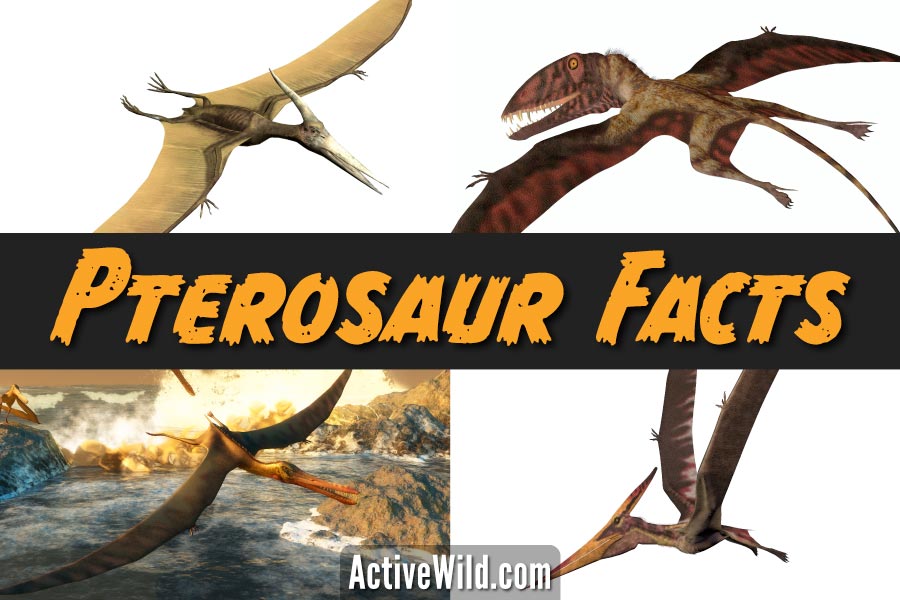Pterosaur facts, pictures and in-depth information.
Flying above the heads of the dinosaurs were another group of distinctive Mesozoic Era animals – the pterosaurs. These amazing prehistoric winged reptiles were the first vertebrates to fly.
On this page you’ll become a pterosaur expert as you find out about pterosaur evolution, the different types of pterosaur, and much more…
Page Index
- What Is A Pterosaur?
- Pterosaur Vs Pterodactyl
- Types Of Pterosaurs
- How Many Pterosaurs Were There?
- Pterosaur Characteristics
- Did Pterosaurs Have Feathers?
- Were Pterosaurs Cold-Blooded?
- Could Pterosaurs Walk?
- How Big Were Pterosaurs?
- Pterosaur Evolution
- What Was The First Pterosaur?
- Fun Facts On Pterosaurs
- What Did Pterosaurs Eat?
- Where Did Pterosaurs Live?
- Is A Pterosaur A Dinosaur?
- Are Pterosaurs Birds?
- Are Birds Descended From Pterosaurs?
- When Did Pterosaurs Live?
- Discover More About Pterosaurs On ActiveWild.com
What Is A Pterosaur?
A pterosaur is an extinct, winged, flying reptile that lived alongside the dinosaurs during the Mesozoic Era. Pterosaurs appeared around 220 MYA (million years ago), in the Late Triassic, and went extinct during the Cretaceous-Paleogene Extinction Event, which occurred 66 MYA.
Pterosaurs were the world’s first flying vertebrates. The largest pterosaurs, such as Quetzalcoatlus and Arambourgiania, are the largest flying animals ever to have lived.
Pterosaurs were not the world’s first flying animals: that title goes to the insects, who had been flying for over one hundred million years before pterosaurs appeared.
A pterosaur’s wings were membranes of skin and muscle. The wings were attached to the elongated fourth finger of each of the animal’s forelimbs. Special joints in this finger allowed the wings to be folded upwards and out of the way when not in use.
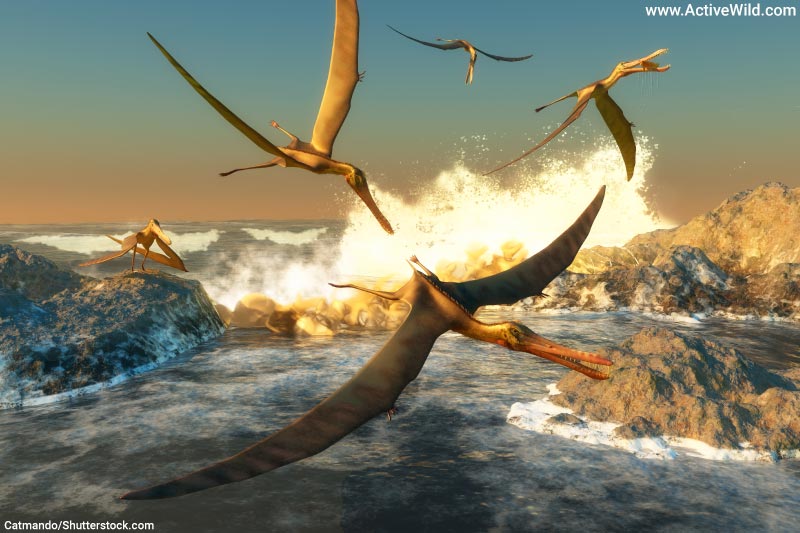
Many pterosaurs lived in coastal habitats and were specialized fish-eaters, but pterosaurs also adapted to be scavengers, meat-eaters, insectivores and omnivores.
Pterosaur Vs Pterodactyl
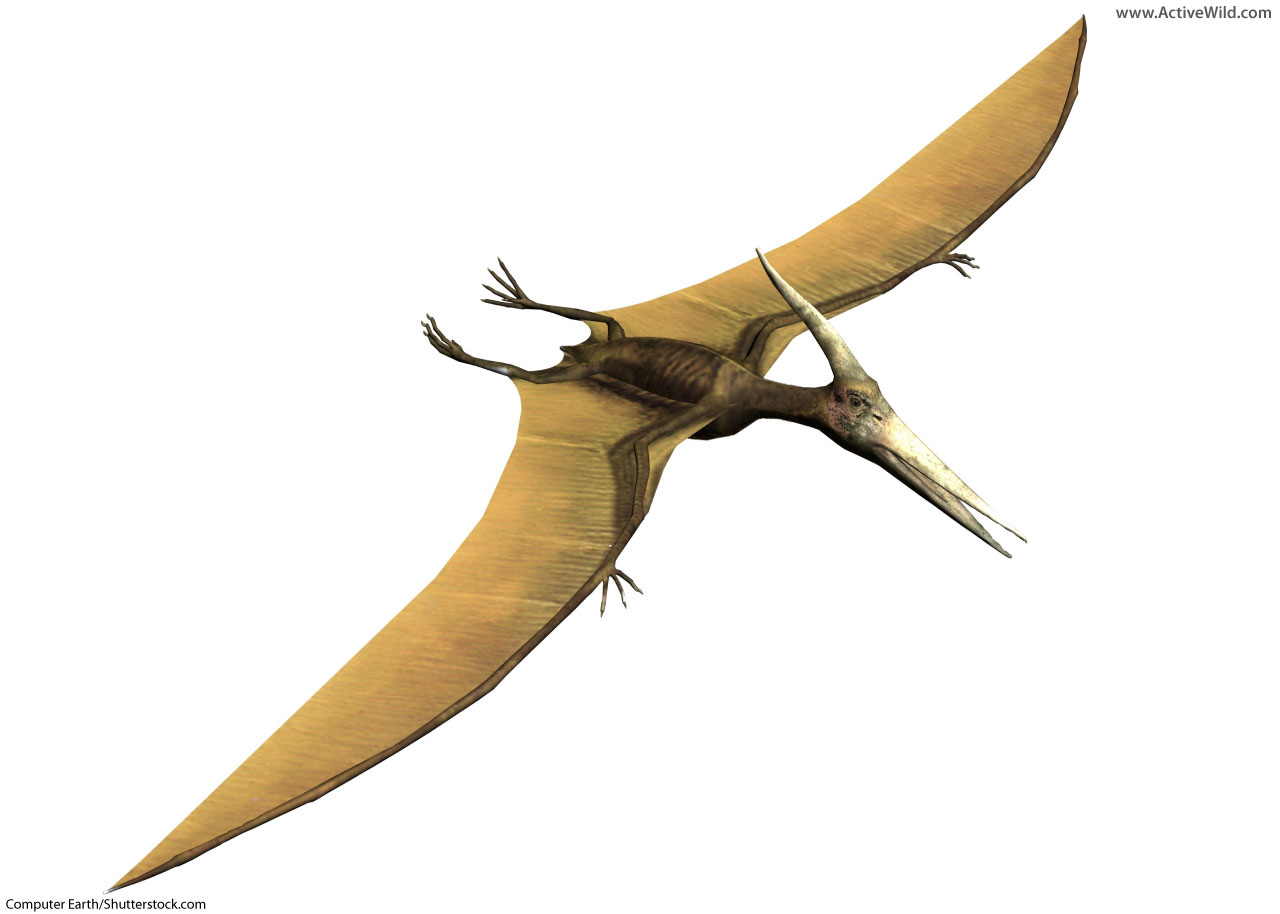
Pterodactylus was the first pterosaur to be discovered and correctly identified as a flying reptile. The first specimen was found in 1784, in the Solnhofen limestone of Bavaria, Germany.
Because Pterodactylus became so well-known, the name “Pterodactyl” is sometimes used (incorrectly) to refer to any Pterosaur.
- You can find out more about Pterodactylus on this page: Pterodactylus Facts
Types Of Pterosaurs
Pterosaurs made up the order Pterosauria. Pterosauria is traditionally divided into two main groups, or suborders: Rhamphorhynchoidea and Pterodactyloidea.
Rhamphorhynchoidea – The First Pterosaurs

Rhamphorhynchoidea contains early pterosaurs such as Eudimorphodon, Dimorphodon and Rhamphorhynchus. These pterosaurs are characterized by their long tails and toothed jaws. Most early pterosaurs lacked bony crests (although several had crests made of soft tissue). The tails of several early pterosaurs ended in widened, diamond-shaped flaps, which may have assisted with steering when the pterosaur was flying.
Most rhamphorhynchoids had become extinct by the end of the Jurassic Period, although some are believed to have survived until the Late Cretaceous.
Pterodactyloidea – Advanced Pterosaurs
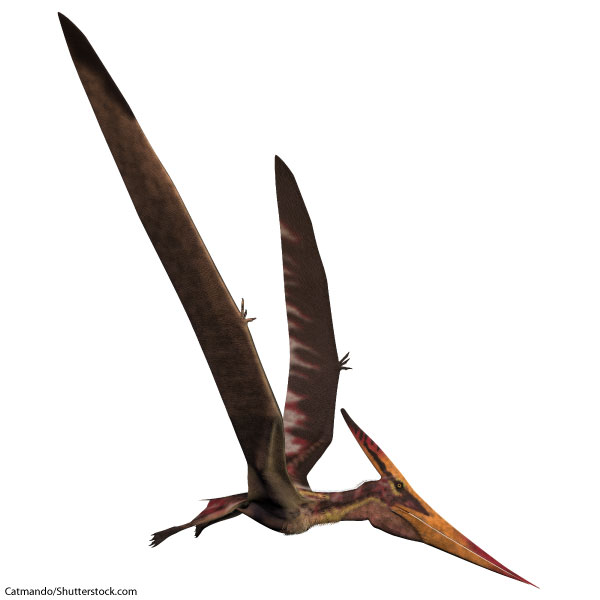
Pterodactyloidea contains pterosaurs such as Pterodactylus, Pteranodon and Quetzalcoatlus.
The pterodactyloids appeared in the Late Jurassic, having evolved from earlier pterosaurs. Their tails were short, and many had bony crests on their heads. By the end of the Cretaceous Period, most pterodactyloids lacked teeth.
The Pterodactyloids became extinct in the Cretaceous-Paleogene Extinction Event that also killed off the (non-avian) dinosaurs.
How Many Pterosaurs Were There?
Currently, around 250 types of pterosaur have been identified.
Pterosaur Characteristics

Hollow Bones
Pterosaurs had many characteristics to aid flight. Their bones were hollow to reduce weight, yet strong to enable the flapping motion that propelled them through the air. A system of air-sacs in the bones (and in the wings of some pterosaurs) enabled efficient transfer of oxygen to the hard-working wing muscles.
Excellent Vision & Large Brains
Pterosaur skulls have large eye sockets, suggesting that pterosaurs had excellent vision – a necessary characteristic for a flying animal. Another characteristic of pterosaurs was a relatively large brain (for a reptile), which was necessary to deal with the complicated task of flying.
Beak-like Mouth Parts
Pterosaurs had beak-like mouth parts. The flying reptiles diversified to fill many ecological niches, and the skulls and teeth of different types of pterosaur reflect their diets.
Specializations include: tweezer-shaped bills and flat teeth for finding and crushing shellfish; sharp, interlocking teeth for catching fish; and large numbers of thin, comb-like teeth for filtering food from the water.
The most advanced pterosaurs lacked teeth entirely.
Pterosaur Wings
The fourth finger of each arm of a pterosaur was elongated. The animal’s wings stretched between these specially adapted fingers and its hindlegs, possibly attaching to the ankle.
A smaller membrane extended forward from the long fourth finger to the shoulder, and a wing also stretched between the hind legs. In later pterosaurs, this was reduced or divided to enable faster movement on the ground.
The wings of pterosaurs were membranes of skin, muscle and blood vessels, strengthened by fibers called actinofibrils. The muscle present in the wing likely helped shape the wing as the pterosaur flew, to provide maximum maneuverability and efficiency.
Did Pterosaurs Have Feathers?
Pterosaurs didn’t have true feathers, but the heads and bodies of many, if not all, pterosaurs, were covered with fur-like filaments known as pycnofibers. pycnofibers were also present in many dinosaurs, and may have been the structures from which true feathers eventually evolved.
Were Pterosaurs Cold-Blooded?
The presence of fur-like pycnofibers has led many paleontologists to believe that pterosaurs may have been endothermic (warm-blooded).
Pycnofibers were thought to play a part in temperature regulation (how an animal controls its body temperature), by preventing heat loss.
If an animal is warm-blooded, or endothermic, its body is able to control its own temperature, without having to rely on the environment. (Endothermic animals don’t have to bask in the sun to raise body temperature, for example.)
Could Pterosaurs Walk?
A special joint in the elongated wing fingers enabled a pterosaur to fold its wings upwards when not in use. When on the ground, pterosaurs walked on all four limbs.
Analysis of the skeletons of early pterosaurs suggests that they were good climbers, better adapted to moving around on a vertical surface, such as a tree trunk or cliff face, than walking on the ground.
A downside of the pterosaurs’ membranous wings was that, unlike birds, pterosaurs couldn’t easily run. This is a possible factor in the eventual dominance of birds over pterosaurs in many niches.
How Big Were Pterosaurs?
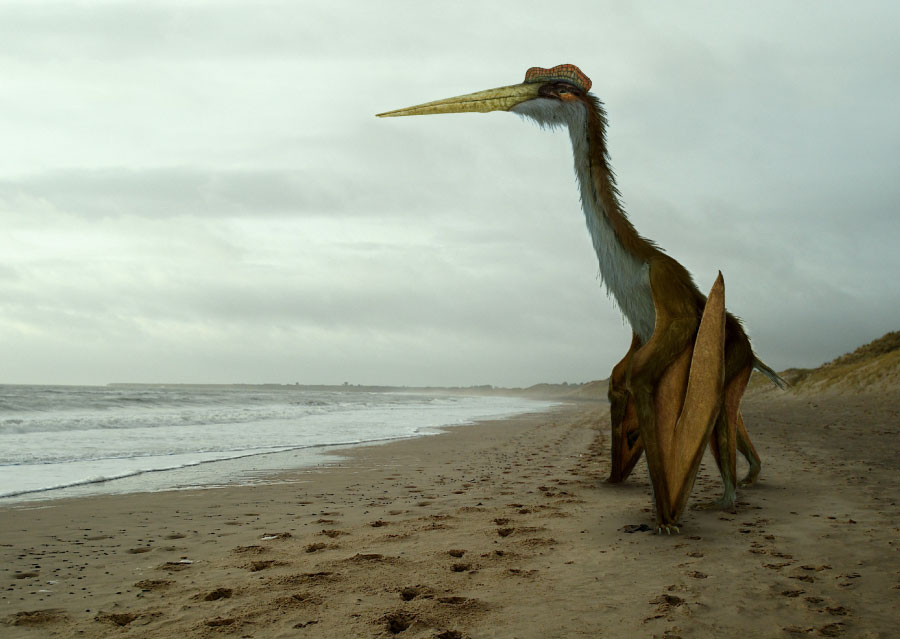
Pterosaurs varied widely in size. The smallest genera were crow-sized, while the largest were the size of a small plane and taller than a giraffe.
The Smallest Pterosaur
One of the smallest pterosaurs was Nemicolopterus, which had a wingspan of around 25 centimeters / 10 in (although the only known specimen of this genus may have been a juvenile).
The Largest Pterosaur
The largest pterosaur was Quetzalcoatlus. This North American pterosaur of the Late Cretaceous had a wingspan of around 11 m / 36 ft., and, with its long neck extended, stood over 3 m / 9.8 ft. tall.
Pterosaur Evolution

Pterosaurs appeared around 220 MYA, during the late Triassic.
Like dinosaurs, pterosaurs were archosaurs. Archosaurs were a group of reptiles that appeared early in the Triassic Period.
As the Triassic Period progressed, archosaurs split into two main groups: Avemetatarsalia and Pseudosuchia.
Both pterosaurs and dinosaurs were avemetatarsalians. The other group, Pseudosuchia, contained the ancestors of today’s crocodilians (crocodiles, caimans, alligators and gharials).
Before the dinosaurs rose to prominence in the Jurassic Period, pseudosuchians were the dominant land animals. They evolved to fill many niches, and some were large, dinosaur-like predators.
Most pseudosuchians became extinct in the Triassic-Jurassic Extinction Event, a mass extinction that occurred between the Triassic and Jurassic periods.
Pterosaurs and dinosaurs shared a common ancestor, likely an early terrestrial avemetatarsalian similar to Lagerpeton, a 70 cm South American reptile of the Late Triassic.
Eventually Avemetatarsalia split into two main groups: the dinosaurs and the pterosaurs.
Pterosaurs likely evolved from reptiles such as Sharovipteryx, a gliding reptile that lived in Central Asia in the Middle Triassic, or Scleromochlus, a small Triassic reptile that moved by hopping or jumping. The fossilized remains of Scleromochlus were found in Scotland.
What Was The First Pterosaur?
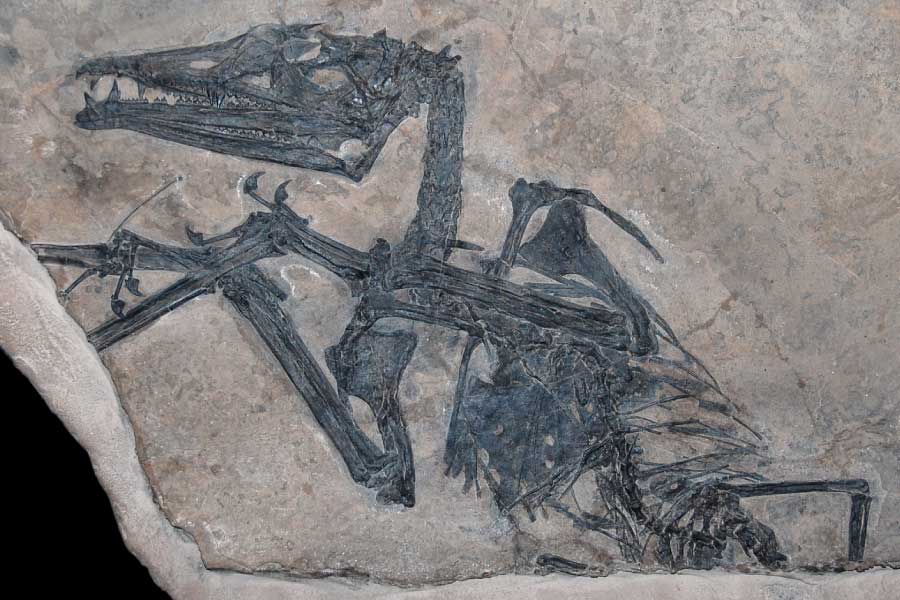
One of the earliest-known pterosaurs is Eudimorphodon. Eudimorphodon specimens have been found in Italy and Greenland. This early pterosaur had a wingspan of around 1m / 3ft. 3in., and its jaws contained around 110 teeth: some pointed, some more suited for grinding food. From the shape of the teeth, paleologists believe that it was a fish-eater.
Fun Facts On Pterosaurs
What Did Pterosaurs Eat?
Typically thought of as being coastal, fish-eating animals, pterosaurs also lived inland, and had a range of feeding habits: some were insectivores, some were scavengers, some hunted on the wing and some may even have hunted on the ground.
Where Did Pterosaurs Live?
Pterosaur fossils have been found on all continents, including Australia and Antarctica.
Is A Pterosaur A Dinosaur?
No, a pterosaur is not a dinosaur. Although both pterosaurs and dinosaurs share a common ancestor within the reptile group Avemetatarsalia, the two groups diverged in the Late Triassic period.
Are Pterosaurs Birds?
No, pterosaurs are not birds, but they are more closely related to birds than any living animal. Birds are descended from dinosaurs, which split from pterosaurs in the Triassic Period.
The closest living relatives of birds are the crocodilians, whose ancestors had split from the dinosaur line before the divergence of the dinosaurs and pterosaurs. (This means that dinosaurs and pterosaurs are more closely related than dinosaurs and crocodilians.)
Are Birds Descended From Pterosaurs?
No, birds are not descended from pterosaurs. Pterosaurs became extinct at the end of the Cretaceous Period, leaving no descendants. Birds evolved the ability to fly independently of the pterosaurs and existed alongside pterosaurs for much of the Cretaceous Period.
Birds are descended from dinosaurs, and are the only members of this group to have survived the Cretaceous-Paleogene Extinction Event. Today, many scientists consider birds to be dinosaurs.
When Did Pterosaurs Live?
The first pterosaurs appeared around 220 MYA, during the Late Triassic. The Triassic Period was the first period of the Mesozoic Era – the “Age of Reptiles”. The Triassic Period was followed by the Jurassic Period, which was followed by the Cretaceous Period – the final period of the Mesozoic Era.
Pterosaurs lived until the end of the Cretaceous Period, becoming extinct in the Cretaceous-Paleogene Extinction Event that occurred 66 million years ago.
Pterosaur Facts: Discover More With Active Wild
You can find out more about pterosaurs and prehistoric life in the following pages:
- Triassic Animals – Discover The Animals That Lived With The Dinosaurs In The Triassic Period
- Jurassic Animals – A List Of Animals That Lived In The Jurassic Period (That Weren’t Dinosaurs!)
- Cretaceous Period Animals That Weren’t Dinosaurs
- Dinosaur Facts, Pictures & Information. Discover The Rulers Of The Mesozoic Era!
- Dinosaur Periods: Discover the Triassic, Jurassic & Cretaceous Periods of the Mesozoic Era
- The Triassic Period Facts For Kids & Adults: The Ultimate Guide to the First Period of the Mesozoic Era.
- The Jurassic Period Facts: The Ultimate Guide To The Second Period Of The Mesozoic Era
- The Cretaceous Period Facts: The Ultimate Guide To The Third & Final Period Of The Mesozoic Era

